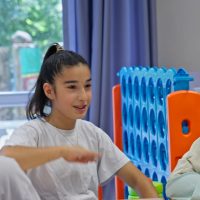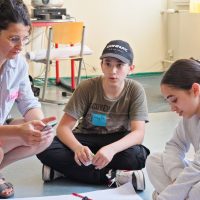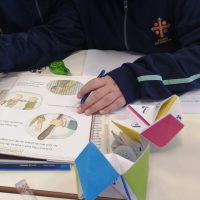Human rights education
Everyone has the right to Human Rights Education (HRE), which is vital to the realisation of rights. It is a lifelong learning process that helps us respect and stand up for each other, with invaluable tools to oppose injustice and discrimination at every level, from the playground to the world stage.
As part of Seen and Heard, Amnesty International Poland has delivered teacher training on human rights education.
Human rights education has three dimensions:
- Learning about human rights: Gaining knowledge about what human rights are, and how they are defined and protected;
- Learning through human rights: Ensuring that the learning environment and process reflect human rights values – such as participation, respect, freedom of thought and expression. In human rights education, how we teach is just as important as what we teach;
- Learning for human rights: Developing the skills, attitudes and values needed to apply human rights in everyday life and to take action, individually or collectively, to promote and defend them.
What is Human Rights Education?


Human Rights Education (HRE) is for everyone, children and adults alike, and is vital to the realisation of rights.
Human rights are not set in stone – they need to be understood and defended for people to thrive. After all, it is extremely difficult to stand up for ourselves and each other in difficult situation if we do not own our rights.
Various international treaties assert this. They include the 1948 Universal Declaration of Human Rights, which says that the right to education ‘should strengthen respect for human rights and fundamental freedoms’.
The UDHR was a coming together of world leaders and thinkers saying ‘never again’ after the horrors of World War Two and the Holocaust. It offered hope and alifetime of legal protection to everyone, from birth to death. It is rooted in universally shared values such as truth, fairness and equality.
The 1989 UN Convention on the Rights of the Child obliges all ratifying governments (including those of Poland, Malta and Germany) to educate everyone about children’s human rights.
In 2004, the General Assembly of the United Nations proclaimed the World Programme for Human Rights Education (2005 – ongoing).
Read our Blog on Human Rights Education here
HRE teacher resources
We have produced a set of five educational resources, under the heading Seen and Heard: Creative Journeys into Children’s Rights. Details of each of these resources, and an introduction to them by their author, Sita Brahamchari, can be seen below.
Seen and Heard: Creative Journeys into Children’s Rights is a set of five educational resources designed for children and young people aged 10–14. Written by award-winning author Sita Brahmachari with Amnesty International Poland, the materials combine storytelling, art, drama and reflection to bring children’s rights to life in creative and engaging ways.
Each resource focuses on a different theme:
- Hear Me, See Me: A Creative Introduction to Children’s Rights
- In Our Hands: Exploring Freedom of Expression Through Creative Action in Our Communities
- The Power of Empathy: Standing Up for Refugee and Migrant Rights
- Empowerment Through Solidarity for Human Rights
- Global Citizens Take Action: Creative Protest for Change
What makes these resources special?
The activities are playful and flexible – from building a Children’s Rights Tree to designing Hands of Change or imagining a Welcome Suitcase. They encourage young people to reflect on fairness, speak up about issues that matter to them, and explore how empathy and solidarity can create change.
How to use them
The resources are free to download and can be used in schools, youth groups, libraries or at home. Each one includes ready-to-use lesson plans, reflection questions and printable worksheets. Educators can follow them as a full programme or select individual activities depending on the group’s needs and time available.
Why it matters
Children are not only the citizens of the future – they are citizens today, with rights that must be respected. These resources support teachers, parents and youth workers in creating safe and inspiring spaces where every child feels seen, heard and empowered to act.
“These expertly crafted and straightforward human rights teaching resources are timely and essential for teachers to use in classrooms to help children confidently explore issues around their rights, so they can advocate within their communities with empathy and compassion.”
– Hans Svennevig, Subject Leader Citizenship and Deputy Programme Leader Secondary PGCE, UCL Institute of Education
Download the resources

Resource 1: A Creative introduction to child rights
Hear Me, See Me: A Creative Introduction to Children’s Rights
Contains four lesson plans featuring playful and thought-provoking activities that help children understand their rights and express themselves.

Resource 2: Exploring freedom of expression through creative action
In Our Hands: Exploring Freedom of Expression Through Creative Action
A flexible, creative human rights resource that supports young people to understand, explore and express their right to freedom of expression through discussion, writing, drama and art.

resource 3: The power of empathy
The Power of Empathy: Standing Up for Refugee and Migrant Rights
Contains interactive speaking, writing, drawing, crafting, discussion and drama activities focus on a vital human right: the right to claim asylum – and the possibility that every single human being, if placed in a position where safety and home were threatened, might need this right.

resource 4: Empowerment through solidarity for Human Rights
Human Rights Education Resource 4
Empowerment through Solidarity for Human Rights

resource 5: Global citizens take action - creative protest for change
Human Rights Education Resource 5
Global Citizens Take Action: Creative Protest for Change

Story Explorer – a fun way to explore literature and human rights

